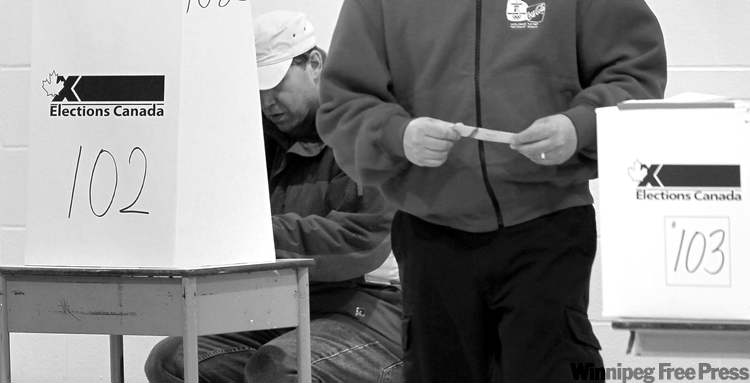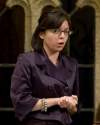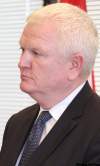No breakthrough in turnout
Advertisement
Read this article for free:
or
Already have an account? Log in here »
To continue reading, please subscribe:
Monthly Digital Subscription
$1 per week for 24 weeks*
- Enjoy unlimited reading on winnipegfreepress.com
- Read the E-Edition, our digital replica newspaper
- Access News Break, our award-winning app
- Play interactive puzzles
*Billed as $4.00 plus GST every four weeks. After 24 weeks, price increases to the regular rate of $19.00 plus GST every four weeks. Offer available to new and qualified returning subscribers only. Cancel any time.
Monthly Digital Subscription
$4.75/week*
- Enjoy unlimited reading on winnipegfreepress.com
- Read the E-Edition, our digital replica newspaper
- Access News Break, our award-winning app
- Play interactive puzzles
*Billed as $19 plus GST every four weeks. Cancel any time.
To continue reading, please subscribe:
Add Free Press access to your Brandon Sun subscription for only an additional
$1 for the first 4 weeks*
*Your next subscription payment will increase by $1.00 and you will be charged $16.99 plus GST for four weeks. After four weeks, your payment will increase to $23.99 plus GST every four weeks.
Read unlimited articles for free today:
or
Already have an account? Log in here »
Hey there, time traveller!
This article was published 03/05/2011 (5282 days ago), so information in it may no longer be current.
A cliffhanging finish, history turned upside down, Quebec and the NDP doing things few ever imagined — and no sign that Canadians flocked to the polls in droves.
With nearly every poll reporting in the Atlantic provinces by press time, the vote was up from 47.7 per cent in 2008 to 52.5 per cent in Newfoundland and Labrador, but down in New Brunswick and Nova Scotia, and up just a smidgen in Prince Edward Island.
Forget the heady days of national voter turnout well above 70 per cent as recently as the 1980s — Election Canada’s running totals suggested Canadians were going to be in the low 60s, if not the 50s.

In Manitoba, despite several still-too-close-to-call races at 10 p.m. Monday, turnout was only 43.6 per cent with almost four out of five of the polls reporting.
However, advance polling was strong, and that had yet to be rolled into the totals.
Nevertheless, Ontario and Quebec appeared to be on the way to maybe three voters in five making it to the polls — at best.
“Everyone got into a tizzy in 2008 about advance-poll numbers, and the turnout was still low,” said University of Manitoba political science Prof. Jared Wesley. “I think this will be much ado about nothing.”
Pollster and professor Chris Adams predicted the NDP surge and the attention paid to leadership in this race would create greater voter interest and push up the turnout overall when everything was counted.
“We follow the pattern: From ’93 to ’08, we’re a little below the national average,” said Adams, vice-president of Probe Research and an adjunct professor of political science at the University of Winnipeg. “When it dips in Canada, it dips in Manitoba; when it’s up in Canada, it’s up in Manitoba.”
In the 1980s, Canada’s voter turnout was in the mid-70s, with significant issues differentiating the parties. That had been standard for decades.
Voter turnout is affected by the feeling that your vote counts, Adams said.
“At the macro level, it looks like a very competitive race; at the micro level, it’s quite different,” he said.
That means regardless of what the national polls say, most people expect the Conservatives to win handily in Alberta in almost every riding, and that can hold down the turnout.
Voter turnout in the Manitoba ridings varied remarkably in 2008, from 40.1 per cent in enormous and geographically dispersed Churchill, to 65.6 per cent in Winnipeg South and 65.7 in Winnipeg South Centre, both affluent ridings.
Generally, turnout has been higher in Winnipeg ridings than outside the city, and higher in middle-class ridings than in low-income ridings.
Back in the elections between the world wars, Manitobans often trekked to the polls in greater numbers than the rest of Canada. In 1926, 77 per cent of us voted, and only 68 per cent nationally.
As late as the free trade election in 1988, we matched the national average of 75 per cent, but the last time we exceeded national turnout was when Joe Clark fever swept the country in 1979 — turnout was 77-76, score one for Manitoba.
But come 2008, only a shameful 56.1 per cent of us bothered to vote.
Even flood evacuees were able to vote Monday.
A special poll was set up for fewer than 100 evacuees from Roseau River First Nation who have been staying in Winnipeg for more than a week.
A mobile poll also went around to two different Winnipeg hotels so evacuees from Peguis First Nation, north of Winnipeg, could cast their ballots.
A flooded road in the community of Oak Lake meant polling stations at the town’s community hall had to be moved to nearby Kenton, affecting about 180 voters.
nick.martin@freepress.mb.ca












